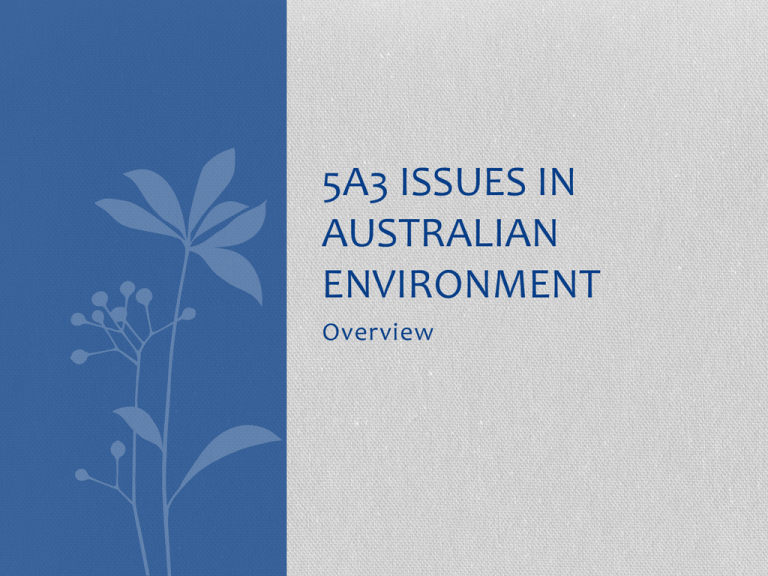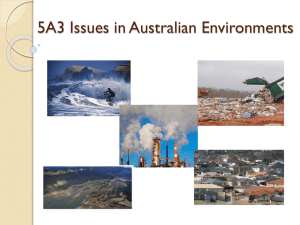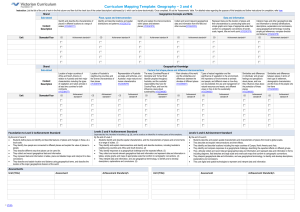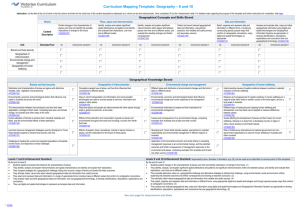Introduction & Overview of Australian Environmental Issues
advertisement

5A3 ISSUES IN AUSTRALIAN ENVIRONMENT Overview Syllabus • geographical issues affecting Australian environments including: • air quality • coastal management • land and water management • spatial inequality • urban growth and decline • waste management • describe each geographical issue in relation to: • its nature • its impacts • the responses by individuals, groups and governments to the issue • outline how a range of geographical issues are affecting Australian environments What is a Geographical Issue? • Geographical issues involve the interaction of the physical and human environments and have the following aspects: • A spatial dimension – where and why the issue is occurring • An ecological dimension – the way humans interact with the physical and human environment • A particular scale – local, regional, state, national or international What's Involved? • Geographical issues involve the interaction of the physical and human environments and have the following aspects: • Geographical processes – physical and human forces operating to cause the issue • Different perceptions – range of viewpoints or opinions about the issue • Different groups involved in the issue including residents, communities, governments and businesses THE 6 GEOGRAPHICAL ISSUES DEFINED Air Quality • Australians consistently rank air pollution as a major environmental concern. • Is an important factor in the quality of life in Australian cities. • It affects the health of the community • Directly influences the sustainability of our lifestyles and production methods. • The Australian Government undertakes national action to reduce emissions of major air pollutants • The cost of poor air quality in cities is difficult to accurately measure but has been linked to a number of health problems. • Two major pollutants are: • Pollution from reliance on motor vehicles. • Pollution from industry. • The National Pollutant Inventory measures the amount of substances released into the air and can be tracked per suburb • http://www.npi.gov.au/npidata/action/lo ad/summaryresult/criteria/year/2011/destination/ALL/ postcode/2154/sourcetype/ALL/subthresholddata/Yes/substance-name/All How Areas Are Divided • National policies and programmes run by federal, state and local governments relate largely to the reduction of emissions from three sectors: • Transport: National initiatives aim to reduce the impact of road transport on environment quality, urban amenity and human health. People's travel behaviour is also targeted, including promotion of bicycle use for short journeys. • Residential: such as heating with wood, back yard burning and domestic appliances, are small but numerous, and as the National Pollutant Inventory shows, can be significant sources of air pollutants. Another emerging issue is indoor air quality. • Industry: Emissions from larger industries are reported under the National Pollutant Inventory and are subject to State/Territory control programmes. Land And Water Management • There have been significant changes to many of the natural environments of Australia since European settlement in 1788. • The biggest changes include: • ✪ replacing native vegetation with crops and pastures • ✪ grazing native grasslands • ✪ altering the natural river systems for irrigation. Coastal Management • In comparison with many countries of the world, Australia possesses an enormous continuous coastline. • Australia's coast including islands stretches for about 60 000 kilometres and comprises over 10 000 separate beaches. • About two-thirds of the population live in the towns and cities that have been built to take advantage of the many benefits the coastline brings. The geographical processes relevant to coastal management • Atmospheric processes – • caused by such elements as temperature change, storms and the force of the wind. • Biotic processes – • plant and animal life and the way they interact. • Geomorphic processes – • uplifting forces within the Earth’s crust, which create sea cliffs or the forces of erosion and deposition. • Hydrologic processes – • action of the waves, the tides and ocean currents Positive Impacts • These changes have had impacts. Some of the impacts have been positive. • They have provided a rich farming landscape that provides us with the food we eat, the fibres we wear and the resources we build with. • They have also contributed to a strong and wealthy economy and stable society. Negative Impacts • These costs include the land and water management issues of: • ✪ water use and irrigation • ✪ pollution of waterways • ✪ farming impacts on soil and water quality • • • • • ✪ catchment management ✪ mine-site rehabilitation ✪ salinity and erosion ✪ biodiversity ✪ river management. The Consequences • As a result, in 2001 about 10 per cent of Australia’s natural environments was assessed in the National Land and Water Resources Audit as highly stressed. • The factors that have been identified as causing stress include: • lack of native vegetation • high levels of threatened ecosystems and species • high levels of dry land • salinity • weeds • feral animals Spatial Inequality • The term is used to describe the relationship between where people live and their standard of living • For example not everyone in Australia has the same standard of living. • Some people drive imported luxury cars while others cannot afford a car at all. • Some have private health cover; others rely solely on the public health system. • There are groups in society that take overseas holidays every year and those that never take a holiday. • Some people live in suburbs or areas that are considered to be ‘rich’ while others are ‘poor’ • By considering the spatial dimension, we are considering where and why inequality exists in Australia. Consequences of Spatial Inequality • People experiencing poverty or inequality are excluded from full involvement in their community and therefore from active citizenship. • They may be excluded because they can’t afford the right brand of clothes, they don’t have access to a computer or they can’t afford the price of a bus fare. Urban Growth And Decline • Australia is a highly urbanised country with over 85 per cent of the people living in cities and large towns. • While the population of Australia as a whole has grown steadily, most of the growth has tended to be concentrated in the large urban areas. • In particular, the capital cities, and urban areas surrounding them, have experienced the highest rates of growth in recent years. • Many rural areas, by contrast, have experienced little or no population growth and some have actually declined. Consequences of Urban Growth • Urban areas vary in the way people are concentrated living in relatively small spaces. • This concentration can be measured as population density. Some cities, such as New York, Paris and Tokyo, have large numbers of people occupying a relatively small land area because they have more high-rise residential buildings. • Australian cities have developed with relatively low population density. • This is the result of the prevalence of single-storey dwellings, sometimes referred to as bungalows. The city tends to expand outwards, taking up more and more land for housing. The reasons for this are partly historical and partly because of the greater availability of land in Australia. • In cities in Asia and Europe, land is relatively scarce and this forces the development of high-rise accommodation. High-rise blocks of apartments are very common while single-storey bungalows are rare Waste Management • Waste is an issue that relates to all areas of the environment. • There is potential for inappropriately disposed waste to contaminate land and groundwater with heavy metals and other toxins • There may be lacking some government oversight of waste management • The release of methane and other gases from decomposing waste is also an issue as this contributes to greenhouse gas emissions and poor air quality. • Non-biodegradable plastics are also a concern as these persist in the environment for many years and can wash into oceans and estuaries, harming marine and bird life Consequences of Waste Management • • • • • International evidence suggests that economic growth contributes to growth in the amount of waste generated per person (Productivity Commission 2006) As the total volume of waste generated in Australia increases, so does the importance of businesses that exist to extract and recover materials from waste Waste has social implications, especially for those who reside near waste disposal sites. Poorer health outcomes may be a concern for residents living near waste disposal sites. Also, proximity to disposal sites may reduce property prices and income sources, which is also an issue affecting people's wellbeing. Civics and Citizenship • Once geographical knowledge and management solutions about an issue are developed it is important that this knowledge is used effectively to promote a more sustainable and equitable future for all Australians. • Civics involves the knowledge of effective ways individuals, groups and governments can influence the decision-making processes about an issue. • Citizenship involves action or exercising your rights to influence the decisionmaking processes to ensure a fair and sustainable outcome.











